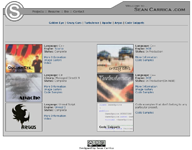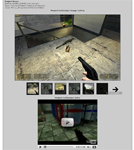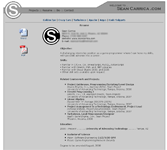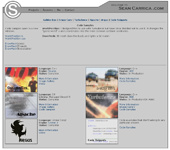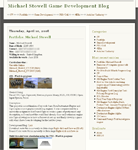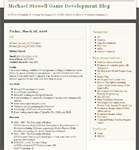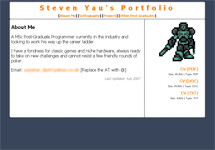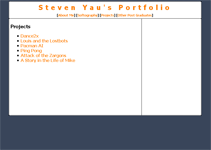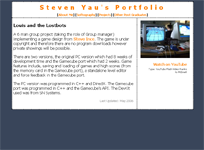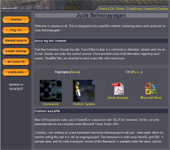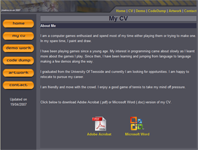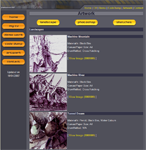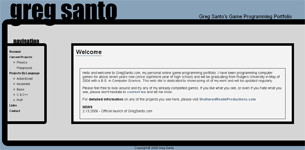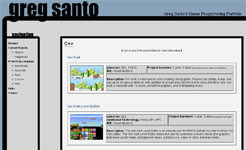Introduction
Whether you are a graduate or someone who is self taught, your demo portfolio is the key to getting your foot in the door of the games industry. As a junior applying for their first position it doesn't matter if you graduated with honours from the best University in the country, without a good portfolio you will not even be considered for an interview let alone be offered a job. Unfortunately it's one of those questions that gets asked again and again, with rarely a concrete answer given and a lot of misinformation is often brought forward.
I started my career in the games industry straight out of University back in 2001 so I know what it's like worrying about what games companies expect and what you should do to show them you are the right candidate for the job. Over the past few years (on a daily basis depending on the time of year) I have been responsible for reviewing portfolios and interviewing candidates for programming roles at Blitz Games Studios and I have seen some pretty amazing work examples... and some that should have been but were just not there. Hopefully this article will show you what I and a lot of other companies look for when an aspiring Junior Programmer's CV lands on our desks and how you can show a company just how good you really are.
This article will be broken up into three parts. The first will cover the content of a demo portfolio, the second will cover the presentation of this content (which can be just as important) and the final part will look at real portfolios to see what went right and what went wrong.
What Should Be In A Portfolio?
The first and most important element to decide on is what exactly needs to go into a portfolio. The main thing to remember is that this demo is meant to impress the person who will eventually offer you a job, so it needs to be your best work. There is no point including half-finished, broken pieces of work as it will do nothing to push you forward. You also need to think about how you want to be viewed. Are you interested in general game play programming or are you really interested in special effects, physics or one of the other many things people can now specialise in?
If you are interested in specific areas then you need to include multiple demos' to prove you're not just a one trick pony. Physics for example could include technical demos that feature...
- Dynamic cloth
- Rigid body physics
- Deformation
If you are interested in general game play programming (and this is usually where most juniors start) then you can do nothing better than include a range of different but complete games, both 2D and 3D. What kind of games would be expected though is usually the hardest question to answer - though having a specific company in mind gives you a head start as you will already know what kind of games they have a history of developing. One thing you need to understand is that, regardless of whether you have a degree or not, you are not expected to make something as playable as Halo or as good looking as Crysis.
To quote a post from the forums on GameDev.net:
"In modern days you will basically not get through the door without a college degree unless your portfolio is truly astounding. (By astounding I mean you are able to do things that no one can do in realtime; or you have developed an entirely new technique for... )."
This is simply not true, your demo portfolio needs to be good, but even some of the worlds best studios won't have technology that produces the kind of output that this statement alludes to.
Complete and Finished Work
So what kind of completed games would be expected for a standard junior entry level position? Try some of the following:
- Asteroids clone (full of special effects, explosions and particle effects)
- Simple 3D death match (AI bots, 3D character models etc.)
- Simple TBS Game (2D like Advance Wars or even 3D with the effects and environment to go with it)
The thing to note is that you do not need to have games that are huge and that take months or years to complete. People understand that you have a life outside your hobbies and that you like doing other things. And taking that further, chances are if you over-stretch, you simply won't achieve what you want, meaning nothing will be finished and your portfolio will not be as good as if you concentrated on smaller, manageable demos.
Now it's worth pointing out that in both cases, I stated that you needed a complete game. A complete game is just that, something that has the flow of a full game, from the menus to the game and back out again. Other things that you can include in a complete game would be
- Front End - Start new game, options, exit game etc.
- Loading Screens
- High Score Tables - People love these
- Pause Menus
Graphics, Style and Good Looks
Another question asked is how good these games should look. If you read this blog post you are expected to be a programmer, nothing more. Programmer art is more than acceptable for demo portfolios. If you have friends who can help you out then all the better, but you will not be viewed in a negative light because you are not a fantastic modeller or pixel artist.
University Course Work
Graduates will also have work they did as part of their University program (yes, the content covered so far is generally assumed to have been done in your spare time), and there is every chance the quality of this is high and suitable for the portfolio. One thing I would recommend if adding this is to make a clear distinction between your course work and work you did off your own back. More on this in part 2, but it is worth noting that here.
Making Sure It All Works
So now you have an idea of what to include, there is still a lot more to do to make sure your portfolio is complete and ready to be put together. Your games and demos probably use a wide range of external libraries and API's (DirectX, OpenAL and OpenGL to name a few). Unfortunately, your PC is probably the only one that has the right combination of installs to make your demos work. So it is vital that you include (or provide a link to) the relevant installers that will be needed. This will mean the reviewer has instant access to what is needed and can install things easily instead of rooting around for one missing library (at which point they may well just decline your application).
It cannot be stressed enough that making sure you include everything, or ideally wrap a games install process into a single executable, is vital to a good portfolio. A reviewer will be willing to spend time on your work, but not if that involves spending 10-15 minutes simply setting it up and chances are that if there are multiple steps involves some of them will be missed. The easier it is to run your game, the easier it is for the reviewer to start enjoying what you have to show.
Right, so we should have everything we need now and everything is perfect, right? Wrong. Imagine what happens when the reviewer tries to run your demos and (even though you tested it on machine after machine) it fails to run. None of your demos do in fact. This is another reason a lot of applications get rejected. So how can you avoid this? The simple answer is that you can't, as chances are your game will crash on someone's machine no matter how much testing you do, so the trick here is to make sure they still know what you can do even if they can't run your work.
So for each demo and each game you need the following
- High quality screen shots of all major features of the portfolio
- Videos of each demo showing the good bits
Source Code - A Window into a Programmers Mind
So, anything else? Just one more thing and this can be one of the most important parts of a good portfolio. You need to include the source to all the demos included in your portfolio, and it needs to be easily readable and accessible (this is where free copies of various .net IDE's come in handy).
But why is the source code important when you have the most amazing demos ever seen? A lot of the time, the journey is more important than the destination. People like to see how you approached a problem, and how you worked around common dilemmas but most importantly that you write consistent and safe code. The source code will also open up another line of questions if you get to the interview stage which can help you shine even more.
You need to make sure that the source code is clean and suitable for other people to read. Take that to mean that any abusive or inappropriate comments and variable names need to be removed (though they should never exist in the first place), and it needs to be well structured and laid out. Best to do this from the start rather than the day before you build your portfolio, as you wouldn't believe how easy that is to spot.
The source code also allows people to find out one of the most important aspects of any demo: what parts of it are yours and what parts were done by someone else. This needs to be clear in the code (and in the portfolio itself) as you do not want to be seen as someone taking credit for someone else's work - this will get you nowhere.
And That's It?
Now I know some people will be saying that this is going overboard, and not everyone will produce portfolios that have everything mentioned here. And they are correct, most people won't. But the best people will, and it is these people that will get jobs in the games industry and it is the bar they set that everyone is judged against. It is these people you are competing against and it is these people that you need to stand out against, second best simply won't do.
Presenting Your Portfolio
I'll admit before I continue that some people will say this part comes down to personal preference or possibly even goes beyond what is needed, but you have to understand that companies are looking for the best applicants, and the best applicants always add the finishing touches. If your demo is placed next to someone who has taken on board elements listed here, then it will look like the other applicant wants it just that little bit more. And if your demos are of a similar level, well, you can imagine where I am going with this...
What's So Important about the Presentation?
So you finally have your demo work, fully tested and everything you need to include, ready to be sent off to the companies you dream of working for. The presentation will be the final touch, showing people you care about what you are showcasing and that you're willing to finish what you started.
A good presentation allows people to actually find your work. Your demo might contain executables, screen shots and videos along with a collection of source code - all that for each project that makes up your portfolio. Unless you present it in a way that allows the reviewer to easily find this content, some of it can be easily missed or simply glossed over especially when the reviewer has many portfolios to look at.
Presentation also allows you to group relevant information or projects together. You may have a couple of projects that showcase your technical side (physics or AI demos), a couple more that show the development of gameplay and maybe some university projects. Being able to group these together allows the reviewer to see the most relevant demos to the job you are applying for, meaning you look better suited to the job than someone else.
Finally, by controlling the presentation you are controlling how the reviewer approaches your work. Do you want to guide them directly to the best content or do you want to start with your earliest work and guide them through the development of your skills showing your ability to learn? If you have a well presented portfolio you know what is being looked at and can control how it is being viewed.
Your Target Audience
One of the most important parts of a portfolio is understanding who you are presenting to. This is designed to be a professional portfolio being presented to other professionals for a valued role in their company. You need to tailor the way you write to contain a suitable level of technical language, but you don't want to go over-board - be careful you don't come across as a term dropper or someone who may be trying to hide behind big words. Humour is always welcome but you need to be aware that what you find funny isn't necessarily to everyone's taste - be careful here and only include it if it is natural and not forced.
The following is a description of different methods that can be used to present your work and while there are others these are the most widely used and easiest to put together.
A Collection of Zip Files
The simplest way to present your work is to compress each project and send them via e-mail or via a large file hosting website (YouSendIt.com for example). While this is definitely the quickest way to get your work out to companies it is without doubt not the best and something that should be avoided. The following are just some of the problems that can crop up when using this method:
- Many companies will have strict attachment file size limits so you either have to send multiple e-mails (which can easily be mislaid or mixed up in a large organisation) or limit what you send. If you are trying to impress someone with your work, removing some of that work to try and fit in a 5Mb limit it not the way to go, and (referring to the first part of the article) there is no way you can include everything you need to in an e-mail attachment (broken up or not).
- File hosting websites often have a time limit on how long they will store your files. I have received links to sites like these where the attachment is no longer valid or has timed out. This will happen more than you think. Busy schedules, holidays or late viewing of CV's can mean that your work won't be looked at, or even downloaded, a week or two after you upload it.
- Once your zip files have finally reached a reviewer, how they view the contents will greatly depend on the way you structured your files and folders. Chances are the small read-me file attached won't be read before diving in because it's so easy to ignore. So how do they find your best work?
- Some zip files or e-mail systems will strip executables from the package. This usually happens if the sender doesn't test their work but I have received small portfolios with no executables even though the sender assumes they are there!
- 01 Project Name 1
-
- Executable - Containing executable to run the game
- Source Code - All source code for this project
- Screen Shots - High quality showing all features
- Videos - Covering the best parts of this project
- 02 Project Name 2
-
- etc. etc.
As you can probably tell sending your work as a collection of zip files is not something I recommend and really can break what would otherwise be an excellent portfolio. Would you expect any other professional developer (in any line of work) to do something like this? Then why would you?
A Demo CD
This has generally been the most traditional way to showcase your work and is still one of the most versatile ways to send your work in. Even if you send a CD to a group of agencies they will duplicate that CD and send it on, meaning you lose none of the impact that your initial one had.
CD's also allow you to store everything your portfolio needs (executables, videos, installs and screenshots) and to make it even easier you can set the CD to auto boot so the reviewer goes directly to the good stuff (be that an html file or a .net front-end application). By taking the presentation further you can add custom labels to both the CD and the case stating exactly what's on the CD and whose work it actually is.
Since the structure of a demo CD can be very different, this will be discussed below.
A Portfolio Website
A website is the easiest way to pass your portfolio around to companies across the globe. A link on an e-mail or on your CV means your content can be sent anywhere quickly and to the correct people. While the structure of the website will be covered later (since both the demo CD and website can follow very similar patterns) there are a few things that can be included to make it more professional.
- Get a suitable domain name. These are not expensive and makes it easier to access your work and makes you more memorable. The address www.leewinder.info is much easier to read and remember than www.lee.myfreewebs.yahoo.co.uk for example.
- If you have a personal website, keep it separate. A portfolio is meant to be your professional front and shouldn't be side by side with pictures of your last holiday or of you drunk and off your face in Spain. Trust me, it does happen!
- Link to everything you need. This might be direct links to any required installs or libraries but this information needs to be easy to access and may be quicker to download off other websites rather than your own host.
One thing to note is that while links to sites such as YouTube will give you direct links to videos of your work, some companies will restrict access to community sites through the work day. It's better to include the source videos along with any links just to make sure your work will be seen.
Presentation of Your Portfolio
As you can imagine, a website or demo disk portfolio can be very similar. Whether the CD boots up a .Net application or a webpage, the way this is structured can be very similar to an actual website. The following are a few examples or pointers that can make this presentation clear and concise while directing the reviewer to your work in the way you want them to see it.
- Try to keep your pages direct. A main introduction page covering your portfolio, who you are and what you are looking for (game programming roles, technical roles etc.). Keep to one page per project as this allows your screenshots, videos and executables to be easily accessible and more likely to be read before the demo is actually run.
- Keep the different sections separate so your work is appropriately grouped. Game or tech demos followed by (if applicable) University work are all suitable groupings for your work. This will allow people to concentrate on the sections that are important to them without having to root through less important aspects.
- Have a contact page which contains links to your CV (in both Word and PDF format), phone numbers and e-mail addresses. While these details will also be on your CV, it doesn't hurt to have this information more visible and easier to access.
- Try not to include links to your MySpace or FaceBook pages unless they are being used solely for professional purposes (such as LinkedIn or the Gamesindustry.biz Network). As mentioned before, pictures of you wasted are not going to impress a potential employer.
- Make the information clear and easy to read. Simple colours and clear fonts make a presentation much easier to navigate (please no pink and yellow!). Flash can be nice but you are not showing off your website design skills and over-adding Flash will be the death of any website.
A Quick Recap
So, a quick over-view of what's been mentioned for a portfolio presentation
- Presentation is important because it adds a final touch to your portfolio, making it easy to find the work that matters and allows you to lead the reviewer to what you want them to see
- The people you are pitching your work to are technically minded who know what is happening in the industry so you can use technical language. Just make sure you don't come across as just trying to impress or over-talk the talk.
- Sending a collection of zip files is the easiest way to send your work but can cause problems and make it difficult for the reviewer to look at your work. If you need to send zip files make sure it is well structured, clear and consistent.
- A demo CD or website allows you to structure your work clearly and provide all the required files easily and in one place.
- By structuring your presentation appropriately you can lead the reviewer to the best of your work, showing them various skill sets easily without them having to root for the best bits
- A portfolio is meant to be a professional piece of work designed to showcase you to potential employers. Getting a job in the games industry is not easy and every little helps.
Real World Examples
Finally it's worth taking a look at some real world portfolio's that have been created by people looking to enter the games industry as entry level programmers. As you would expect the easiest way to do this is to use online portfolio's that are publicly available so while this part does have a skew towards the online, the content will be just a relevant to a demo CD or any other presentation method.
For the sake of consistency I have included screen shots along with a web link to the real thing as portfolios tend to change as careers develop and people's skills improve and grow. I should also point out that these critiques are in no way meant to be in-depth reviews of the portfolios. Ideally you should make up your own mind as to how good you think they are and how they could help you develop your portfolio in the future.
Sean Carrica - http://seancarrica.com
Sean's website is very clear and well presented. Every page has a clear (very clear) link to each part of the portfolio which means you can easily dart around the site without having to move back to the home page once you have finished reading the current section. The way the games are linked works quite well, especially as there are only a few and in this case you don't need to really categorize them in any way. If this was required, having smaller, easier to group images under a relevant banner would work quite well.
The CV is presented in multiple formats which always gives the reviewer the option as to how they want to view it. As a user of OpenOffice I am often wary about opening Word documents so a .pdf file makes this much easier to manage. Along with the CV is Sean's brief bio, which really gives an impression of who he is and what he is looking for. While this is easy to access, it would probably be more appropriate on the main page since it covers exactly who he is and would give a reviewer more information without having to look for it.
As for the projects themselves, there is a nice variety of skills on show and it also makes clear where Sean wants to work (game programming rather than tools or engine level you would assume) and the sizes of the projects are appropriate for the roles he would probably apply for. Ideally the C++ projects would be completed (rather than On Hold) since this is the language he will most likely end up working with but the screen shots and code samples give you an idea of the projects and their scope. If Apache was written and completed in C++ then the range of projects would be ideal.
I would also question the inclusion of the Code Snippets section, which by Sean's own admission contains code that was designed for a specific purpose but then not actually used. You would start to wonder why, what were the reasons for not using it yet still including it on the portfolio?
It's a shame that not all the projects (even the on hold ones) have screen shots or demos. Because there are no executables available I would really expect to see this for each one, giving the reviewer the ability to judge the games and assess what Sean could do. Are the projects that do not have video or screen shots available simply not good enough for a portfolio - while I personally doubt this it will cross some peoples minds and reduce the impact of his work.
As you can probably tell, Sean's portfolio is a solid piece of work that contains a good range of projects and is presented very well. The use of a simple, clean URL is a real bonus too. If there were a few things that I would expect to be done slightly differently it would be the following
- Allow me access to the executables so I can actually play the demos - this goes a long way to impressing a reviewer
- While the YouTube links are useful include the source files for download too as this gives more people access to the material and download speeds are generally not an issue
- More completed C++ projects would be a real bonus rather than some incomplete ones that may appear to be tacked on
Michael Stowell - http://stowelly.co.uk
Michael has a very nice range of demo's available for download on his portfolio, some of which are on actual pieces of next generation hardware (obviously a benefit from attending University but one which should be highlighted). Content covering 2D to 3D work using a wide range of C++ API's show that he is capable of working with new technology and new tools without too much trouble, and is also willing to try working in different areas rather than concentrating on what he knows. Each demo provides downloadable executables, all of which worked out of the box on my basic run of the mill development PC. This is a real bonus and either shows Michael spent the time thoroughly testing his demos or is capable of writing good solid code from the off - both are desirable traits for an entry level programmer.
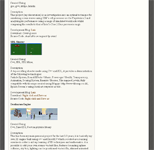 The only
downside of the projects that are available is that some of them seem incomplete and unfinished so it may have been beneficial for Michael to concentrate on a couple less and adding polish to the
remaining ones. This wouldn't have gone against him as he would still have had a good range of projects on show. I would be tempted to say that the main project is possibly too big for a demo
portfolio, especially when there is such a range on show and it isn't a finished piece of work. A more focused and complete main project would probably go some way to making this portfolio
complete.
The only
downside of the projects that are available is that some of them seem incomplete and unfinished so it may have been beneficial for Michael to concentrate on a couple less and adding polish to the
remaining ones. This wouldn't have gone against him as he would still have had a good range of projects on show. I would be tempted to say that the main project is possibly too big for a demo
portfolio, especially when there is such a range on show and it isn't a finished piece of work. A more focused and complete main project would probably go some way to making this portfolio
complete.
Unfortunately, Michael has presented his work in a format that is less than suitable. While blogs are good for simple one off comments or projects they can be very difficult to navigate, especially when there are a multitude of links to other areas of his blog that are not, in the fullest sense, related to his portfolio. There are a lot of links to the right and top of the portfolio that simply clutter the page and make navigation difficult.
This is only made more problematic by every project being in the same entry, so the reviewer has to scroll through multiple projects to get where they need to go - add to that the slim line formatting of a blog and there is a lot of information in a very small space. This proves to be a problem when adding images (which could be linked to rather then embedded) as there is so little space that some of the images are simply to hard to see clearly. As an example of the lack of clear navigation, it took a while but I eventually found links to videos for the various projects, which would only help Michael and should have been linked to with each project and each section.
As a quick over-view, Michael's portfolio contains some very good work and shows off his ability in the field of game development. Unfortunately the presentation is less than ideal and can make a good portfolio seem less that its parts. If I were to suggest some improvements they would be the following:
- If you want your blog to be part of your portfolio, have a link to it and keep the portfolio separate
- Categorize the projects - one project per page with clearer information and links to videos, screenshots and executables
- Links to required API's (if available) otherwise will downloadable executables run on everyone's machines?
- Link videos and screenshots with the projects (again this comes down to format of presentation)
Steven Yau - http://yaustar.no-ip.org
Steven's presentation is remarkably clear and well laid out. There is no additional 'fluff' that can make a portfolio hard to read and navigate, but with the inclusion of both strong colours and images the site has a really clear personality. As with the other portfolio's he's included different versions of his CV for easy access (even including a text file version) and his home page gives a short but detailed enough over-view of where he is in his career.
His projects are of a suitable size of an entry level programmer with the Dance2X being something slightly different that the norm but interesting never-the-less, and along with the other more game related C++ projects, his portfolio is diverse and can really showcase his talent. I think it makes it quite clear that Steven is interested in the game play side of game development and suits its purpose well. It's also nice to see an explanation as to why content (executables, source code etc.) is not available publicly rather than simply not being there. I would argue that the 'A Story In The Like Of Mike' is simply not needed, this is a programming portfolio after all and this just takes up someone's time when it is most likely irrelevant for the kinds of roles Steven is going for.
It could also be made clearer which projects were done as University work and which ones were done as side projects. While it is possible to figure this out, some explanation by simply grouping the projects could help and make the portfolio slightly easier to navigate.
Steven is actually active on various education sites in relation to games and wrote an article on how to break into the Games Industry. Unfortunately you wouldn't know this from looking at his portfolio. While it's not physical evidence of ability, being involved in these kinds of activities is a real bonus and should be advertised clearly alongside his other work.
If I was to suggest anything that needed changing on a portfolio like this it would be the following
- Direct video links along side the YouTube links
- Categorizing of his demo projects into languages or type
- Advertise the fact that Steven is active in the educational elements of the Games Industry
Jude Selvanayagam - http://www.jnselva.co.uk
From a quick glance at Jude's portfolio you can tell he is primarily interested in technology based development rather than game-side programming. The demo projects included in his portfolio are all feature-based and don't include any games what so ever (well there is one...) but for Jude that does exactly what it needs to do. Each project shows an aptitude for different techniques and areas of engine or tools development from physics to special effects and each one is finished to a good level showing the ability to follow through what he started.
Navigation around the site is very simple, though I would avoid calling something a 'Code Dump' or similar, as these are still valid projects and, while not the flag ship ones for the portfolio, are still present and should be highlighted in a positive manner. It's good to see each project, from the main ones to the lesser ones, being given a short description and screen shots, but the particle system and cloth simulation projects should really have a collection of videos, especially as there are multiple downloads to go through if the reviewer wants to look at everything - and to protect against the demos not running on the host PC.
It's quite interesting to see a 'Highlights' section on the main page, which again pushes you in the direction Jude wants you to go, showing off the projects that are the stars of the set and the ones that will hopefully land a good position at a games company.
I'm obviously going to comment on the art work which, while absolutely stunning, really has no place on a programming portfolio. Stress that you are interested in art and sketching on a CV and even provide a brief link to a showcase website but I would be tempted to remove it for the sake of this portfolio.
So if there were a couple of points I would probably recommend changing it would be the following
- Could the projects be highlighted as University work and personal work to make the distinction clearer?
- The tools used for each project should be clearer. Language, API's and methods used should be obvious and at the top - do we know what they were developed in without downloading the source?
Greg Santo - http://www.gregsanto.com/
Before I start I will admit that I think Greg's portfolio is an excellent example of what a portfolio should be and how it should be presented. The first thing that is obvious is how the site is laid out, with the main page giving a good description of who Greg is and what this site is for.
In a portfolio like this, which contains a lot of demos written in a variety of languages categorizing the titles by language is a real winner and allows people to go exactly where thy need to go, which means this could be used not only as a gaming portfolio but also one for a more traditional industry. As for relevant projects, while there is only one project that would spark an interest (it's the Go! Kart one by the way), it's of such high quality that other ones are simply not needed. All the required elements of a game are there from menus, music, level select screens and split screen multiplayer. But, and this is a big but for anyone reading this, creating such a big project is a risk. What if, after a year's development, the project simply didn't come together or was simply not of a good enough standard. In this case that obviously didn't happen but for people looking to create portfolio work this is a big consideration to take when embarking on a large project.
As for the layout and presentation of the project, the main project page has everything you would expect, from nicely laid out code samples, a large amount of screen shots (this almost makes a video redundant but I wouldn't ever go that far!) and something that I think really stands out, which is the challenges faced throughout development. Studios are always interested in people who can learn and tackle new problems, and this clearly shows that Greg has that ability.
Is there anything that could be improved? On the main page the line "you like what you see, or even if you hate what you see" is not a good one. You are selling yourself to everyone who sees your work, so while it can be a throw away line, always assume your work is excellent and assume everyone else will think so. Don't go over-board, but never put yourself or your work down, no matter how tongue in cheek or light hearted it is.
So would there be anything I could possibly suggest should change? If there was it would be the following
- If the main C++ project was smaller, it would obviously be nice other game related projects were present, but in this case that is probably asking too much!
- The current project (the Physics Playground) would definitely benefit from some screen shots of work in progress, if they are available
And Finally...
I'd obviously like to thank the above people who gave me permission to critique their work and their portfolios - without these, this part of the series would be a bit of a dead fish and wouldn't have been as useful as it could be. And just to clarify what a good portfolio can do for you, here is a quick update as to what these people are doing right now (as of July 2008)
- Sean Carrica - University of Advancing Technology in Tempe, Arizona (Software Engineering with double majors in Game Programming and Network Security)
- Michael Stowell - Programmer at Creative Assembly working on Empire: Total War
- Steven Yau - Gameplay Programmer at EA working on the Harry Potter franchise
- Jude Selvanayagam - Technology Programmer at Blitz Games Studios working on BlitzTech
- Greg Santo - Systems Engineer at Pandemic Studios working on Mercenaries 2: World In Flames
Originally published on Engineering Game Development
